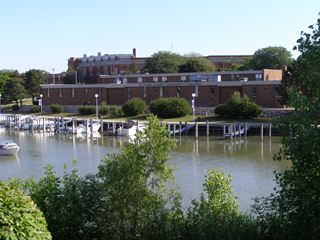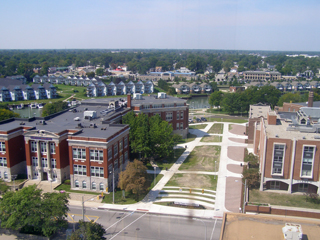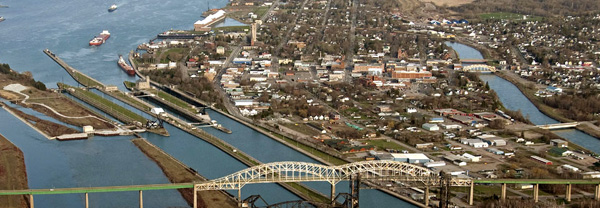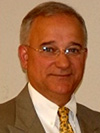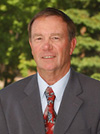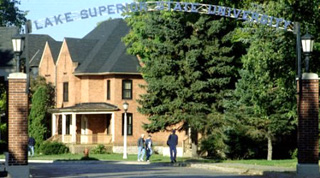By Mayor Susan Baldwin and President Dr. Dennis Bona
Battle Creek has an interesting and unconventional past. Our rich heritage includes former slave and abolitionist Sojourner Truth; Seventh-day Adventist visionary Ellen White; Dr. John Harvey Kellogg, who transformed health care in the nineteenth century; and cereal industry magnates C.W. Post and W.K. Kellogg. We have always held education in high regard, so it is no surprise that our city is home to Kellogg Community College.
Whether you are strolling on the brand new sidewalks and Wave Square of downtown Battle Creek or walking around the beautiful campus of Kellogg Community College just a mile north of downtown, it’s easy to get a sense that everyone is focused on the future.
Young professionals are hustling between office buildings or gathering to discuss their latest innovative ideas on new lighted benches downtown. On KCC’s campus, students are becoming future nurses, engineers, teachers, police officers and entrepreneurs. Professors focus on new technology and educational methods.
The history and future of Battle Creek and KCC are intertwined with strong partnerships and shared goals. KCC partners with the City of Battle Creek and a range of employers, organizations, and educational institutions.
Just a few of the connections between the city and KCC include:
- KCC has teamed with Battle Creek Unlimited, the city’s economic development arm, as well as Michigan Works and Goodwill Industries to develop the “Family Economic Stability” initiative with a grant from the W.K. Kellogg Foundation. This important initiative brings together critical components to assist low-income families in Battle Creek with essential skills and employment opportunities.
- KCC provides work-based learning experiences for students through the Battle Creek Police Department, Bronson Battle Creek, Kellogg Company, Denso Manufacturing and others.
- KCC’s campus on North Avenue contains a portion of the city’s Linear Park Path and the College has an agreement with the Battle Creek Parks and Recreation Department to make athletic facilities available. KCC’s international-sized soccer field, for example, is used for the city’s summer youth soccer leagues.
- City and KCC officials regularly serve together on community boards and initiatives for the purpose of providing better economic opportunities for area residents.
Highlights of KCC’s contribution to the Battle Creek community include:
- The Regional Manufacturing Technology Center, where programs are designed for continuing education and certification or recertification for people in industrial skilled trades. The RMTC is an innovative, community-driven training facility located in Fort Custer Industrial Park. It is home to three KCC programs: Lifelong Learning, Workforce Solutions and Industrial Skilled Trades. Training programs are designed to meet the employee training needs of area business and industry as well the life-long learning needs of community members.
- The Legacy Scholars Program, which provides educational, emotional, social and financial support and opportunities for Battle Creek Public and Lakeview School District students to graduate from high school and obtain a college degree. KCC plays a major role in the Legacy Scholars Program, which provides a scholarship to KCC for all Battle Creek and Lakeview graduates.
- KCC’s Dental Hygiene Program, which operates a dental clinic on the North Avenue campus to provide low-cost dental hygiene treatment for the community. The program also goes off-site to provide oral health education and some limited mobile dental hygiene treatment.
All of these important programs are integral to our quality of life and part of what makes Battle Creek a great place to live. But we can also talk hard numbers.
- Direct wages, salaries and benefits of KCC faculty and staff, plus routine college operations, increase incomes in the KCC service area by at least $21.9 million annually.
- About 37 percent of KCC’s students come from outside the region to attend college in the KCC service area. The effects of these out-of-region students account for around $1.5 million in added regional income.
- College-trained workers deepen Battle Creek’s human capital. This results in higher wages for students, greater returns for property owners, increased tax revenues and higher incomes due to economy-wide multiplier effects. Altogether, it is estimated that the productivity of KCC’s past and present students contributes $217.1 million to economic growth in the KCC service area.
The City of Battle Creek and Kellogg Community College long ago realized that, by working together, we both thrive and prosper.
Opportunities for life-long learning, workforce training and quality community programs through KCC help Battle Creek become more attractive to the young adults of the knowledge economy.
Our city efforts to address neighborhood improvements, entice new shopping and entertainment proprietors and re-build our downtown make our city more appealing to students looking for educational opportunities. This is the spirit of the Battle Creek area, our relentless optimism. Together, we will build our bright future.
Susan Baldwin is the Mayor of the City of Battle Creek and Dr. Dennis Bona is the President of Kellogg Community College in Battle Creek.



















